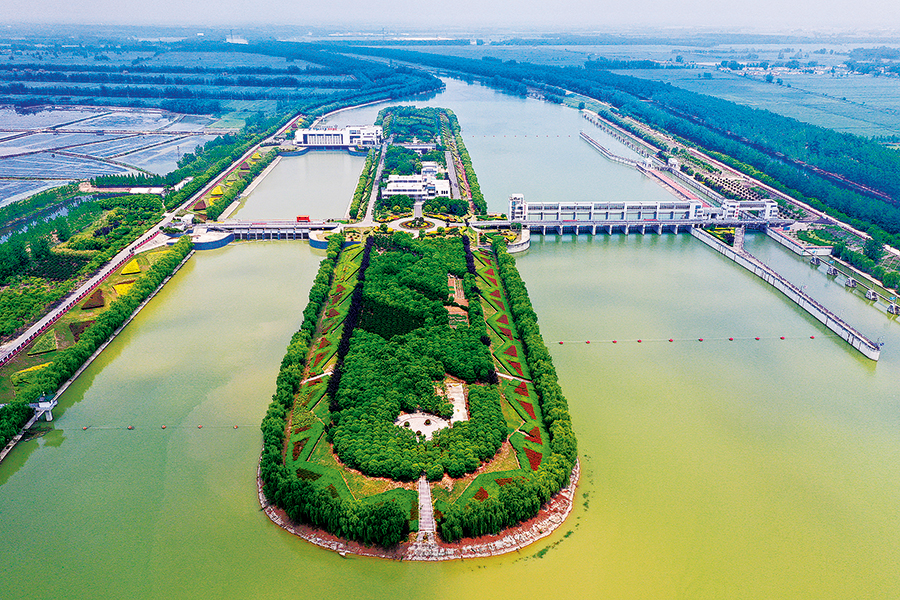Water diversion project brings many benefits

Water diversion facilities in operation at Sihong, Jiangsu. FANG DONGXU/FOR CHINA DAILY
The 2.8 million or so residents of Weihai are among the 68 million people who have benefited from the eastern route, the company said.
It added that as of Sep 30, the route had diverted 40 billion cu m of water from the Yangtze River, over 6.1 billion cu m of which was delivered to Shandong.
The project has far more benefits in addition to addressing drought in the northern part of Jiangsu and many areas of Shandong, as I saw during my interview tour.
Thanks to the project, the Beijing-Hangzhou Grand Canal temporarily had water throughout its 1,794-kilometer length in April last year and also in that month this year. The canal connects Beijing and Hangzhou, capital of Zhejiang province.
Canal upgraded
As part of the construction work for the eastern route, almost 18 km of new watercourses were built and a section of the canal more than 92 km long was upgraded in Jiangsu. In Shandong, navigable sections of the canal totaling 62 km were constructed, and the increased water levels now permit larger ships to pass through.
Navigable sections of the 2,500-year-old canal, many parts of which once dried-up, have now reached 877 km, making it second in China to the Yangtze River in terms of navigation capability.
Without the water diversion project, there would be no Liangshan Port in Jining, Shandong, which went into operation in 2021.
When I visited the port, a crane was busily loading and unloading containers from trucks powered by liquefied natural gas. An intelligent automation system was used to unload coal from rail trucks.
Kong Zekai, an employee at the port, said it handled more than 18 million metric tons of cargo last year, adding that inland water transportation is not only cost-effective, but also environmentally friendly.
Before the port was put into operation, coal from Inner Mongolia autonomous region and Shanxi and Shaanxi provinces was first transported via the Watang-Rizhao Railway to Rizhao, Shandong, before being shipped to many southern areas of the country.
Now, the coal reaches Liangshan Port first, before being carried south via the canal. "The transportation costs were significantly reduced, and about 63 yuan was saved in transporting every ton of coal," Kong said.
Gao Degang, deputy Party chief of the company that runs the eastern route's Shandong branch, is keenly aware of the changes the water diversion project has brought to the province, as he has been engaged in the route's construction and operation since 2004.
Liangshan Port is just one example of the role played by the eastern route in strengthening economic engagement between southern and northern areas of the country, he said.
Moreover, the lack of water once restrained industrial development in many areas. Now, such restraint has been greatly relieved, he said.
Gao has also seen significant environmental improvements at Nansi Lake, which is connected to the eastern route and is the largest freshwater lake in northern China. For example, the Craspedacusta, a rare type of freshwater jellyfish, has been seen in the lake, which has high water quality requirements.
The China Eastern Route Corp of South-to-North Water Diversion said that to date, nearly 1.2 billion cu m of water has been added to water bodies along the eastern route, increasing their surface area from 10,000 square km to 15,000 sq km.
The level of underground water in areas along the route has also risen significantly, it said.
It is hard to estimate the overall economic benefits the eastern route has brought to areas it passes through, but I'm sure that Weihai would not have become the city it is today without support from the project.
During the National Day Holiday this year, when I was in Weihai with my parents, I found that the city has become a popular destination for tourists from across the country, with many attractions being mobbed by crowds of visitors.
Data from the Weihai government show the 20 tourist attractions in the city that charge for admission received more than 1.8 million visitors during the holiday, a rise of more than 257 percent from last year and of almost 161 percent from 2019, when the COVID-19 pandemic emerged.
Without support from the water diversion project, the city would have struggled to accommodate such a large number of visitors.








